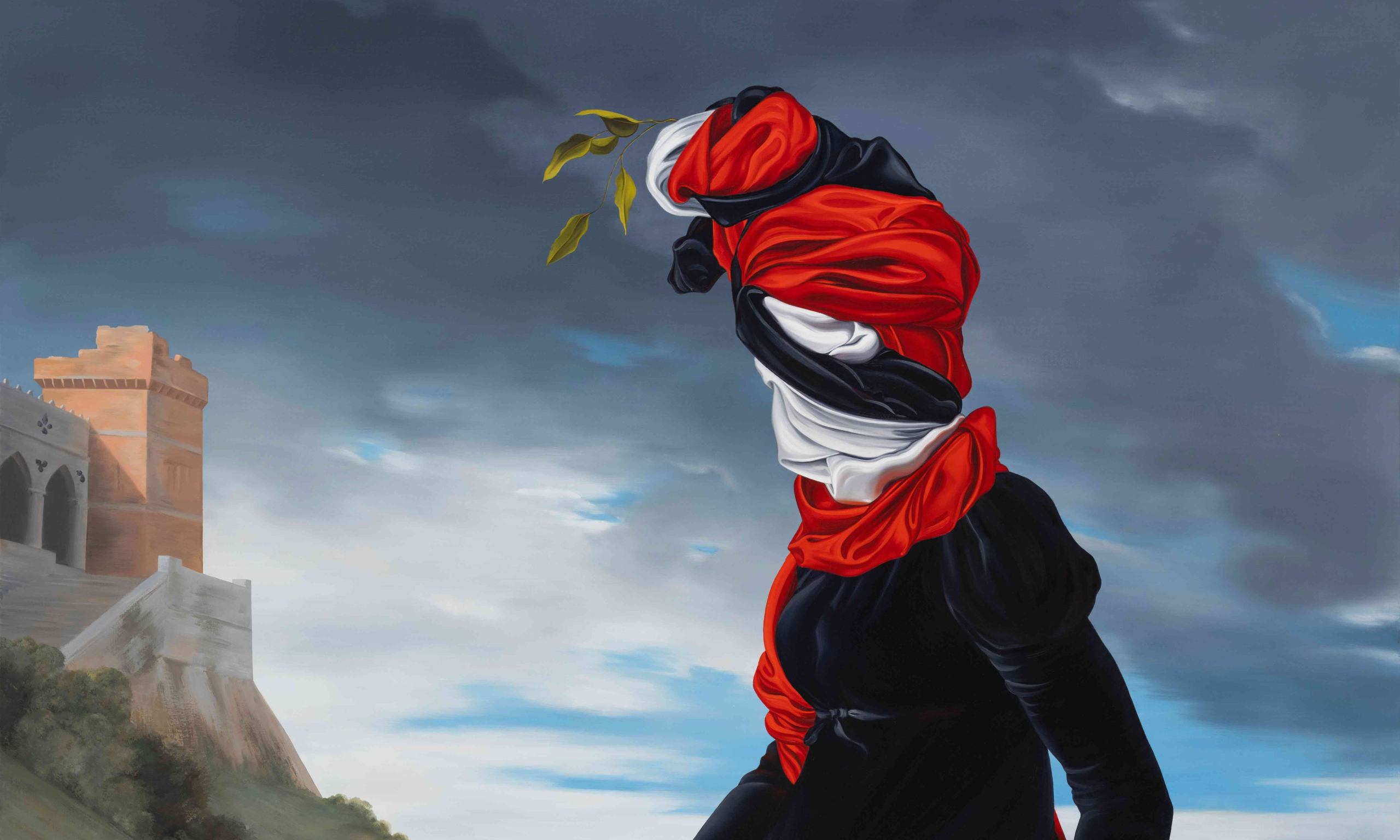Ewa Juszkiewicz, In a Shady Valley, Near a Running Water (after François Gérard) (2023) © Ewa Juszkiewicz; courtesy the artist and Gagosian
In one of the paintings in Ewa Juszkiewicz’s new Venice exhibition, a woman in a long black gown and red shawl perches on a rock, a lyre resting under her left hand. For those familiar with 19th-century French portraiture, this work by the Warsaw-based artist—and recent market sensation—might appear familiar, and so it should. Juszkiewicz’s oil painting, which sits at almost nine feet tall, is inspired by an 1804 portrait by the French painter François Gérard.
Yet while both depict the same subject—Countess Katarzyna Joanna Gabrielle Starzenska, a prominent figure in Polish aristocracy—there is one distinct difference: in Juszkiewicz’s version, the subject’s face is completely covered by wraps of red, white and black fabric. This aesthetic device has become something of a trademark for Juszkiewicz, who uses concealment as a means of drawing attention to, and critiquing, historical depictions of women. As she tells The Art Newspaper: “I want to build my own story of these women, and undermine beauty conventions and idealisations, especially in the art from the 18th and 19th century.”
Locks with Leaves and Swellings Buds at Venice’s Palazzo Cavanis (until 1 September) shows how she has progressed in this mission over the past five years, through a variety of approaches to a subject. Included among the 15 works, all completed since 2019, is Untitled (after Joseph van Lerius) (2020), where thick locks of blonde hair obscure the female subject’s face. There is also Bird of paradise (2023), where the central figure is almost entirely engulfed by foliage, and Lady with a Pearl (after François Gérard) (2024), where a woman is enveloped by a vibrant red cloth, a single pearl dangling from her head.
Ewa Juszkiewicz, Bird of paradise (2023)
Photo: Serge Hasenböhler Fotografie; courtesy of the artist and Almine Rech
In each painting, Juszkiewicz hopes to highlight the ways in which the portraits she is referencing failed to do their sitters justice. In Lady with a Pearl, for example, “I decided only to keep the pearl and cover the whole portrait, which was very idealised,” she says. In her reimagining of Gérard’s 1804 painting of the countess, meanwhile, she hopes to draw attention to the “passive” and “expressionless” depiction of the woman in the original work, despite her being “a celebrity of her time and role model for other women”. She also wants to bring to the fore the contradictions within women’s fashion of the time, which while “beautiful” was also “uncomfortable” and “oppressive”.
Each of Juszkiewicz’s paintings were chosen with the setting of the palazzo, built between the 15th and 16th centuries on the Giudecca Canal, in mind. “The original elements [of the building] like marble are really striking, and I think they are in a great dialogue with my work,” she says. What’s more, she adds, Venice more broadly provides a suitable backdrop, filled with art and architecture that mixes the “contemporary with the traditional, like in my paintings”.
Ewa Juszkiewicz, Untitled (after Joseph van Lerius) (2020)
Courtesy of the artist and Almine Rech
The show comes after a period in which demand for Juszkiewicz’s work among collectors hit heady heights. In 2022, her Portrait of a Lady (After Louis Leopold Boilly) (2019), sold for $1.5m at Christie’s—far surpassing its high estimate of $300,000. Interest has remained high, albeit with prices settling, for now, within six figures.
But this sharp rise to fame “hasn't really influenced the way I work”, Juszkiewicz says. “I just focus on the work and what I want to say.”

